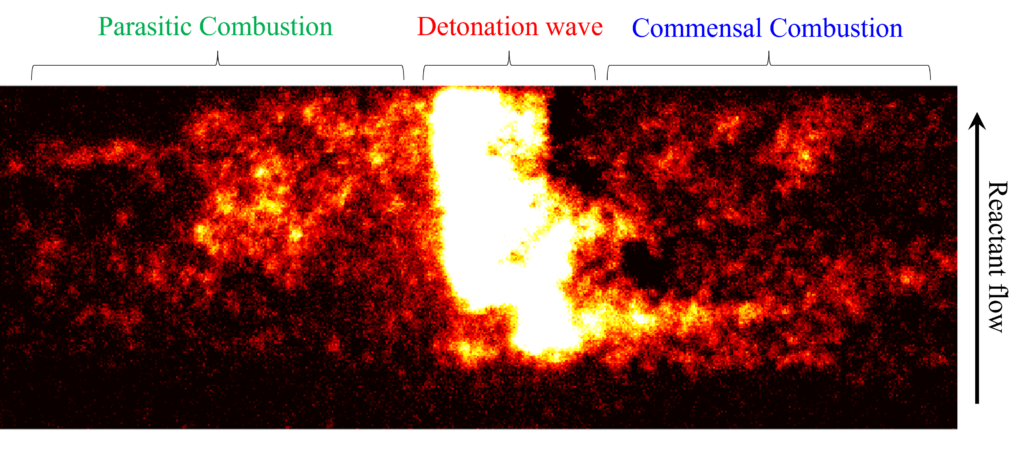
Historical Background
Detonative waves as a means of producing thrust were first theorized in 1950’s by Professor James Arthur Nicholls at the University of Michigan when he built and tested what we now refer to as a pulse detonation engine (PDE). Also around that time, he conceptualized a device where the detonation would continuously rotate (which he termed CRDE); however, the work at the time was limited. Thus, rotating detonation engines (RDEs) have been around since the 1960’s. It is only in the past two decades, however, that RDEs have seen a renewed interest as a next-generation energy conversion device, whether for propulsive or power generation applications.
A RDE is an annular combustor in which a detonation wave is constrained such that it propagates circumferentially consuming the freshly and continuously injected fuel and oxidizer mixture. Detonative combustion of the mixture leads to a gain in stagnation pressure and hence to a higher propulsion efficiency compared to constant pressure or deflagrative combustors, e.g. a gas turbine combustor. In addition to a higher propulsion efficiency, an RDE operates at higher frequencies with no moving parts and is physically compact which makes it attractive compared to PDEs.
Experimental Work
At the University of Michigan, we study these devices to better understand the complex and highly coupled flow-field that arises. This flow-field consists of turbulent injection, chemical kinetics, and acoustic/shock waves occurring simultaneously. Our research investigates everything from geometric parameters of designs to wave dynamics. All the data acquired from high-speed pressure transducers, time-average static pressure measurements, high-speed imaging, thrust measurements, chemiluminescence measurements, and other diagnostics we employ/developed is used to inform design choices to improve RDEs and to understand the physics that govern the resulting flow-field.
Reduced Order Modelling
Conventional laboratory scale RDEs show less than ideal performance, and with the complicated physics and flow regimes within an RDE’s detonation channel, there has not been a complete quantification of the mechanisms behind these losses. Some potential loss mechanisms have likely yet to be discovered or fully characterized, and measurements inside of the RDE channel are difficult, if not impossible, due to the highly unsteady, and extreme combustion environment with timescales on the order of microseconds.
To estimate and quantify potential loss mechanisms, we have developed LeakyDet which is a reduced order model for a RDE cycle that can be calibrated and validated against known measurements that are readily available. This model can help estimate loss parameters and conditions that cannot be accurately measured with current technology. The current effort looks to model the non-ideal regions of combustion within the RDE that could lead to large degradation in performance. The initial results mirror experimental imaging of the RDE but predict additional losses that are not currently accounted for within the model. Additional physics modeling and calibration is required to gain a better understanding of the complete physics experienced within a RDE, and eventually allow for design tools and understanding for these next generation propulsion devices.
Publications
Shepard, Joshua, Alexander Feleo, and Mirko Gamba. “The Effect of Facility Induced Back-pressure on Rotating Detonation Combustor Operation.” AIAA SCITECH 2022 Forum. 2022.
Chacon, F., A. D. Feleo, and M. Gamba. “Secondary waves dynamics and their impact on detonation structure in rotating detonation combustors.” Shock Waves 31.7 (2021): 675-702.
Feleo, Alexander, Joshua Shepard, and Mirko Gamba. “Elevated Inlet Temperature Effects on the Operation of a Rotating Detonation Combustor.” AIAA Propulsion and Energy 2021 Forum. 2021.
Feleo, Alexander, Joshua Shepard, and Mirko Gamba. “Prediction of Detonation-Induced Disturbances Propagating Upstream into Inlets of Rotating Detonation Combustors.” AIAA Propulsion and Energy 2021 Forum. 2021.
Feleo, Alexander, Logan W. White, and Mirko Gamba. “Effects of CO2 Diluent on Rotating Detonation Combustor Operation.” AIAA Scitech 2021 Forum. 2021.
Shepard, Joshua, Alexander Feleo, and Mirko Gamba. “Effects of Inlet Area Ratio on Operability of an Axial Air Inlet Rotating Detonation Combustor.” AIAA Propulsion and Energy 2021 Forum. 2021.
Feleo, Alexander, Fabian Chacon, and Mirko Gamba. “Uncertainties in Thrust and EAP Measurements of a Rotating Detonation Combustor with Axial Air Inlet.” AIAA Propulsion and Energy 2020 Forum. 2020.
Chacon, Fabian, and Mirko Gamba. “Detonation wave dynamics in a rotating detonation engine.” AIAA Scitech 2019 Forum. 2019.
Chacon, Fabian, and Mirko Gamba. “Study of parasitic combustion in an optically accessible continuous wave rotating detonation engine.” AIAA Scitech 2019 Forum. 2019. (Best Paper Award)
Chacon, Fabian, Alexander Feleo, and Mirko Gamba. “Impact of Inlet Area Ratio on the Operation of an Axial Air Inlet Configuration Rotating Detonation Combustor.” AIAA Propulsion and Energy 2019 Forum. 2019.
Feleo, Alexander, et al. “Evaluation of oh emission for determining operation of a rotating detonation engine.” AIAA Scitech 2019 Forum. 2019.
Feleo, Alexander, Fabian Chacon, and Mirko Gamba. “Effects of Heat Release Distribution on Detonation Properties in a H2/Air Rotating Detonation Combustor from OH* Chemiluminesence.” AIAA Propulsion and Energy 2019 Forum. 2019.
Chacon, Fabian, and Mirko Gamba. “OH PLIF visualization of an optically accessible rotating detonation combustor.” AIAA Propulsion and Energy 2019 Forum. 2019.
Chacon, Fabian, and Mirko Gamba. “Development of an optically accessible continuous wave rotating detonation engine.” 2018 Joint Propulsion Conference. 2018.
Chacon, Fabian, James Duvall, and Mirko Gamba. “Evaluation of pressure rise and oscillation in a rotating detonation engine.” 2018 AIAA Aerospace Sciences Meeting. 2018.
Duvall, James, et al. “Study of the effects of various injection geometries on the operation of a rotating detonation engine.” 2018 AIAA Aerospace Sciences Meeting. 2018.
